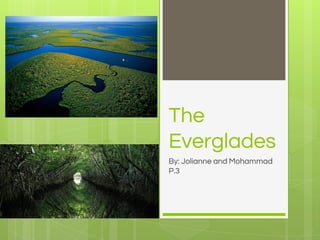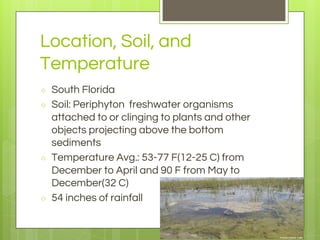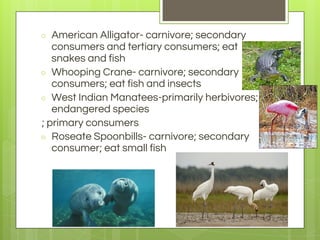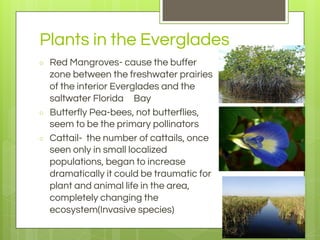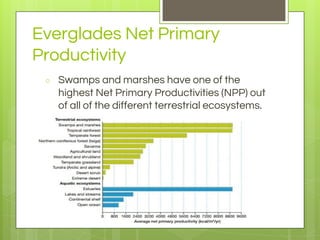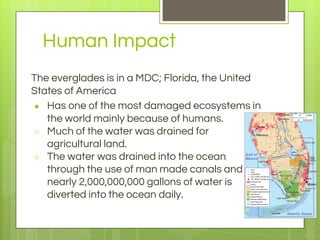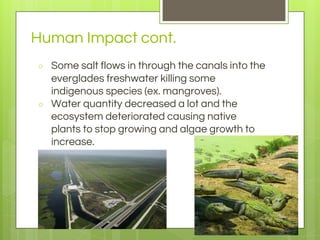The everglades PERIOD 3
- 1. The Everglades By: Jolianne and Mohammad P.3
- 2. Biome and Names ○ The everglades has 2 biomes: Temperature deciduous forest and flooded grasslands ○ The everglades is called: The river of grass and by Native Americans Pa-hay-Okee which translates to grassy waters
- 3. Location, Soil, and Temperature ○ South Florida ○ Soil: Periphyton freshwater organisms attached to or clinging to plants and other objects projecting above the bottom sediments ○ Temperature Avg.: 53-77 F(12-25 C) from December to April and 90 F from May to December(32 C) ○ 54 inches of rainfall
- 4. Climatograph
- 5. The Animals of the Everglades ○ Florida Panther-carnivore; tertiary consumer; eat raccoons that eat fish; endangered subspecies ○ Great Blue Heron-carnivore; secondary consumers; eats fish
- 6. ○ American Alligator- carnivore; secondary consumers and tertiary consumers; eat snakes and fish ○ Whooping Crane- carnivore; secondary consumers; eat fish and insects ○ West Indian Manatees-primarily herbivores; endangered species ; primary consumers ○ Roseate Spoonbills- carnivore; secondary consumer; eat small fish
- 7. Plants in the Everglades ○ Red Mangroves- cause the buffer zone between the freshwater prairies of the interior Everglades and the saltwater Florida Bay ○ Butterfly Pea-bees, not butterflies, seem to be the primary pollinators ○ Cattail- the number of cattails, once seen only in small localized populations, began to increase dramatically it could be traumatic for plant and animal life in the area, completely changing the ecosystem(Invasive species)
- 8. Energy Flow
- 9. Everglades Net Primary Productivity ○ Swamps and marshes have one of the highest Net Primary Productivities (NPP) out of all of the different terrestrial ecosystems.
- 10. Succession in the Everglades ○ Ecological succession is the process of change in the species structure of an ecological community over time. ○ In the Everglades thunderstorms occur in spring and lightning strikes the trees that are growing there. Fire results, killing the trees and allowing native sedges to reclaim the land(ex. sawgrass). ○ Flooding is an example of secondary succession. When a flash flood occurs all of the organisms that reside in the affected land would be disturbed some organisms could get washed away or misplaced, though many organisms would remain.
- 11. Human Impact The everglades is in a MDC; Florida, the United States of America ● Has one of the most damaged ecosystems in the world mainly because of humans. ○ Much of the water was drained for agricultural land. ○ The water was drained into the ocean through the use of man made canals and nearly 2,000,000,000 gallons of water is diverted into the ocean daily.
- 12. Human Impact cont. ○ Some salt flows in through the canals into the everglades freshwater killing some indigenous species (ex. mangroves). ○ Water quantity decreased a lot and the ecosystem deteriorated causing native plants to stop growing and algae growth to increase.
- 13. Human Impact cont. ○ Around half of the everglades became dry land. ○ Fresh water is being drained out of the everglades (some to be used as drinking water) and the water that is flowing into the everglades is often full of pesticides and fertilizers from the agricultural land, polluting the everglades with nitrogen and phosphorous.
- 14. How is the Everglades Handled by the Government? During the settlement of South Florida, canals and dams were dug to drain out the Everglades for agriculture and to build houses. As a result, the Everglades is half its size. The government has gave 7 billion dollars to preserve the remaining and reconstruct it as much as possible. The government has passed laws like the Marjory Stoneman Douglas Everglades Protection Act to restore the Everglades and provide water management districts with clear tools for ecosystem restoration.
